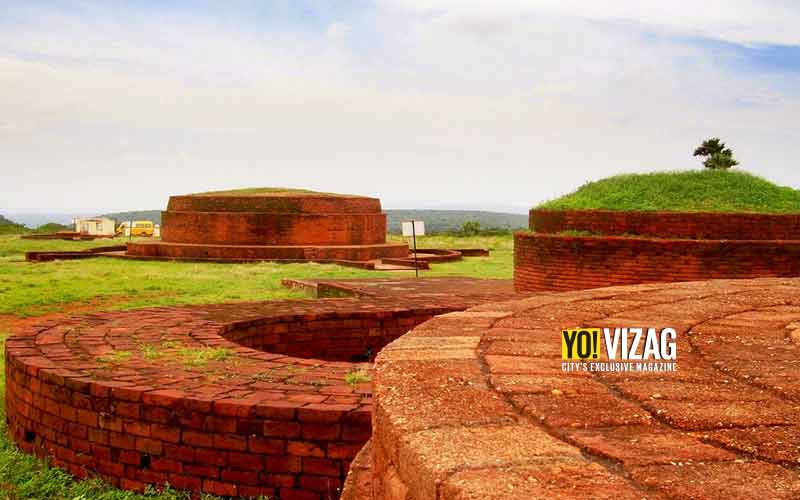
Bavikonda
Vizag has well-known sites for Buddhism as it was under the influence of the Buddhist Empire for quite a long duration. A piece of bone believed to belong to the mortal remains of the Lord Buddha stored in an urn was recovered here. The Buddhist settlements and complexes thought to be active right from the 1st century. The imprint of Buddhist legacy in Vizag is strong and is evident with the findings of the antique Buddhist sites by the archeologists on the hilltops: Thotlakonda, Bavikonda, Bojjannakonda (or Sankaram a 2000-year-old Buddhist Heritage site), and Pavuralakonda of Visakhapatnam city.
Bavikonda is one of the early Buddhist centres of Theravada Style with influences of Sailya Sect during 1st/2nd Century AD. This place has acquired its name due to its wells created to collect rainwater for drinking at this Buddhist establishment. On-site there are many findings like a stone stupa; circular Chaityagruha (an early Buddhist feature); later apsidal Chaitya (Roman Basalica influence); Ayyaka platforms (N Indian influence), a congregation hall, viharas, kitchen-cum-store complex. Roman coins, satavahana coins and pottery dating back to 3rd century BC and 2nd Century A.D were recovered here. But more significantly, Buddha padas, Chattra pieces, Bhrami letters engraved on pottery, stucco figurines were found here.
Bavikonda is considered by many to be one of the oldest and most sacred Buddhist centres in Asia. With a series of hills cleverly carved into stupas, this site is very similar to Borobudur, Indonesia. During the conservation work of Mahachaitya five receptacles containing six silver and gold caskets were recovered from inner brick course of the anda at diagonal points exactly facing the ayaka platforms. One casket is supposed to be carrying Buddha’s relics (presently in Hyderabad Museum).
Thotlakonda came to light during an aerial survey by the Indian Navy, and excavations established the existence of a Hinayana Buddhist complex, which flourished two thousand years ago. The Main stupa constructed on the square platform shows Takshashila influence. On this hill, probably called Senagiri, there were found Brahmiinscriptions of 2nd century AD ‘Drona’, meaning the Telugu word ‘thotla’ or tank, giving this hill its name. The excavations reveal Satavahana lead and Roman silver coins indicating foreign trade; Terracotta tiles stucco decorative pieces, rock trough, deepa stamba, muchulinda naga, sculpture of Nalagiridamana, Buddha padas etc. The Thotlakonda complex has a number of stupas, Chaityas, Viharas, a congregation hall, and a refectory.
Thotlakonda was influenced by the ancient Kalinga region. There are also signs of a confluence of cultures with the Takshashila style, stone railing of Mauryan period, encircling stone wall of Sailya sect, Buddha padas and circular chaityas of Hinayana Buddhism. It is estimated that the monastery accommodated more than a hundred Buddhist monks. 128 meters above sea level overlooking the sea Thotlakonda, on the way to Bheemili town, is flanked by the pristine waters of the sea and the
hilly ranges of the Eastern Ghats.
Distance from Vizag: 41 Km
On the banks of the Sarada River these, Sankaram (derived from Sangharama which meant monastery) near Anakapalli, is host to two Buddhist sites on two small hillocks, the Bojjanakonda and Lingalakonda. These 3rd and 4th-century Buddhist constructions are replete with rock-cut stupas, Viharas, Buddha images, monastery, and sanctuaries. Several antiquities like seals, inscribed tablets, pots, copper coins of 7th century AD have been excavated. The largest monolithic stupa in the world at 64’ and the smallest of only 50×2’ have been found in these sites.
Bojjanakonda (Buddhannakonda) shows all the three phases of Buddhism, Hinayana, Mahayana, and Vajrayana. Clearly visible at the site are Hinayana style rock-cum-brick Mahastupa, the Mahayana styled storied rock-cut caves and the Vajrayana influenced Mahakala image. Samudragupta gold coins and Chalukyan copper coins were found here. In Lingalakonda, the unique aspect is the matsyakaram shape, this has not been found anywhere else in the world.
Pavuralakonda (‘hill of pigeons’) or Narasimhaswamy Konda covering an area of 10 to 12 acres is at a height of 168mts above sea level, near Bheemunipatnam Beach. Excavations revealed nearly 14-16 rock-cut troughs or cisterns used for collecting rainwater, foundations of viharas, with cells and common verandah, circular chaityagrihas, votive stupas, halls etc. Artifacts found were dated between 3rd Century BC and 2nd Century AD. Pavuralakonda is bordered by a chain of hills on the
southwest and northwest and it offers a beautiful view of the curved linear coastline with a crescent-shaped valley.
This post was last modified on 16/10/2020 11:27 am
District Collector M N Harendra Prasad has said that all the officials concerned should work…
It's the end of the week which means no work pressure and ample time to…
Araku Valley and Vanjangi, both the places have their unique fanbases in Visakhapatnam! During winter,…
Vizag is a paradise for food lovers. Every corner of the city has something special…
Rainy days bring with them the perfect excuse to curl up with a cup of…
Visakhapatnam City Police, in collaboration with Apollo Hospitals, has launched a cutting-edge ambulance service to…
Leave a Comment